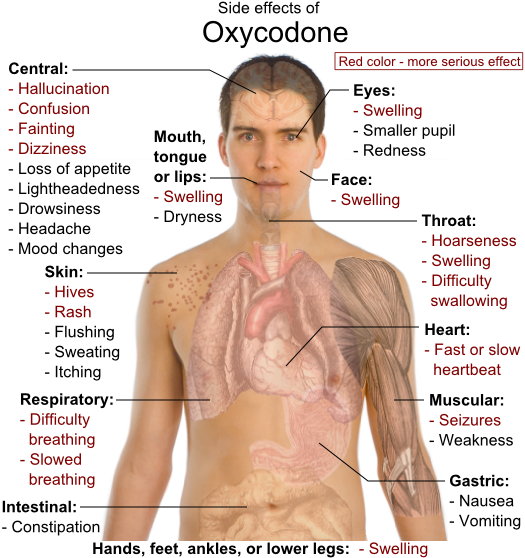Oxycodone
What is it? Oxycodone is a painkiller, aka an analgesic. It is also a narcotic because it is derived from the opiate class of drugs. Oxycodone comes from an element of opium known as thebaine (the other three major elements of opium are morphine, codeine and papaverine). Other drugs that are derived from thebaine include buprenhorphine, oxymorphine, and etorphine (used in elephant tranquilizer).
How is it used? Oxycodone is used in medicine as a prescription painkiller. It is the main ingredient in a number of well-known painkillers, most notoriously OxyContin (sold generically as Roxicodone). Other drugs that include oxycodone are Percocet (oxycodone with acetaminophen), Percodan (oxycodone with aspirin), and Tylox (oxycodone with acetaminophen).
What are the side effects? When properly used, oxycodone does still have some side effects.


How is it abused? Oxycodone has emerged as a major drug of abuse. It can be swallowed in pill form, crushed in order to be snorted (like cocaine), smoked, or even injected. The method by which a person abuses it changes the effects of the drug. If the drug is smoked, snorted, or injected, the effects are much stronger. That is because the coating of the pill is designed to be time-release, so that the effects of the drug are not felt all at once. When you smash up the pill, that function is lost and you can get the full dose at once. This makes the rush greater, and more addictive.
Why is it abused? Oxycodone is abused for its narcotic high.  It makes a person feel a sense of euphoria or relaxation. It is much like heroin and morphine in terms of its effects (and actually is a proven gateway drug to heroin abuse).
It makes a person feel a sense of euphoria or relaxation. It is much like heroin and morphine in terms of its effects (and actually is a proven gateway drug to heroin abuse).
How can I tell someone is abusing it? You can tell if someone is abusing oxycodone if they exhibit the following signs: low energy, apathy, and/or confusion; cold/clammy skin; dizziness; slow breathing; nausea and vomiting; seizures; pin-like pupils.
More information on Oxycodone - Videos
(may contain adult content depicting situations of abuse – please use caution):